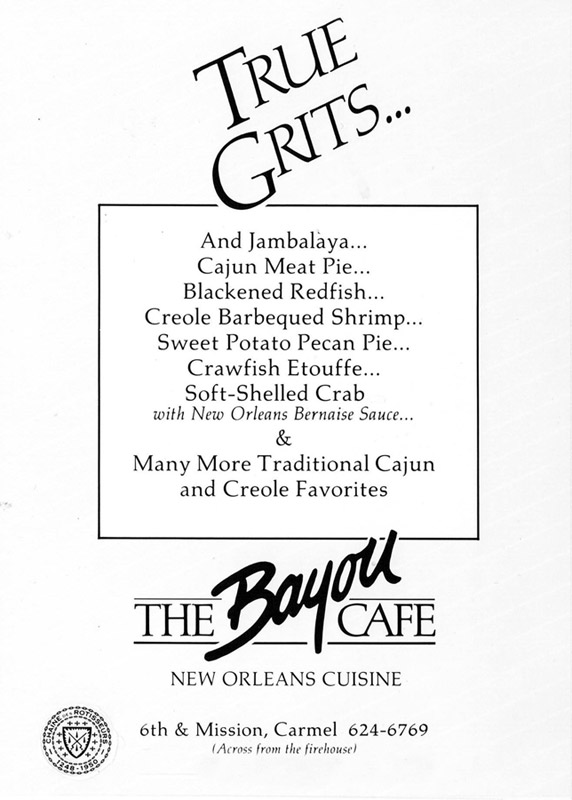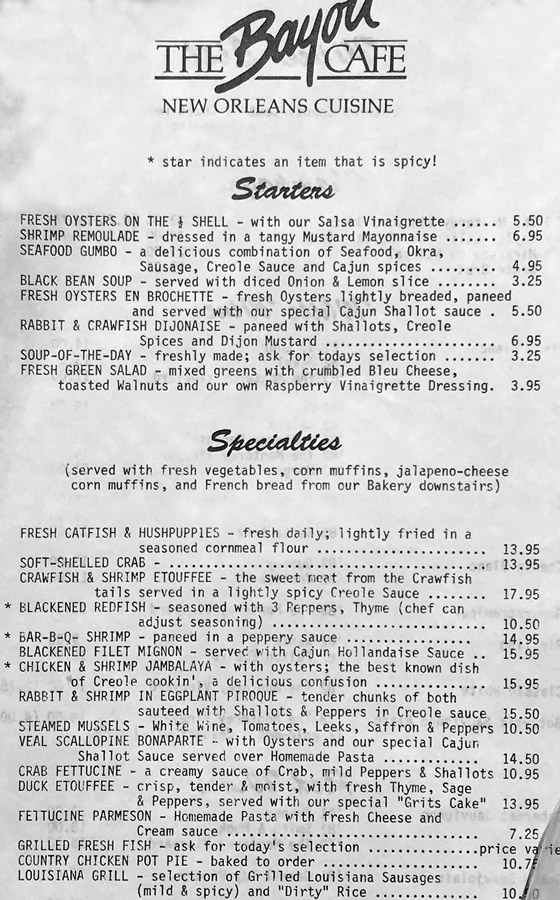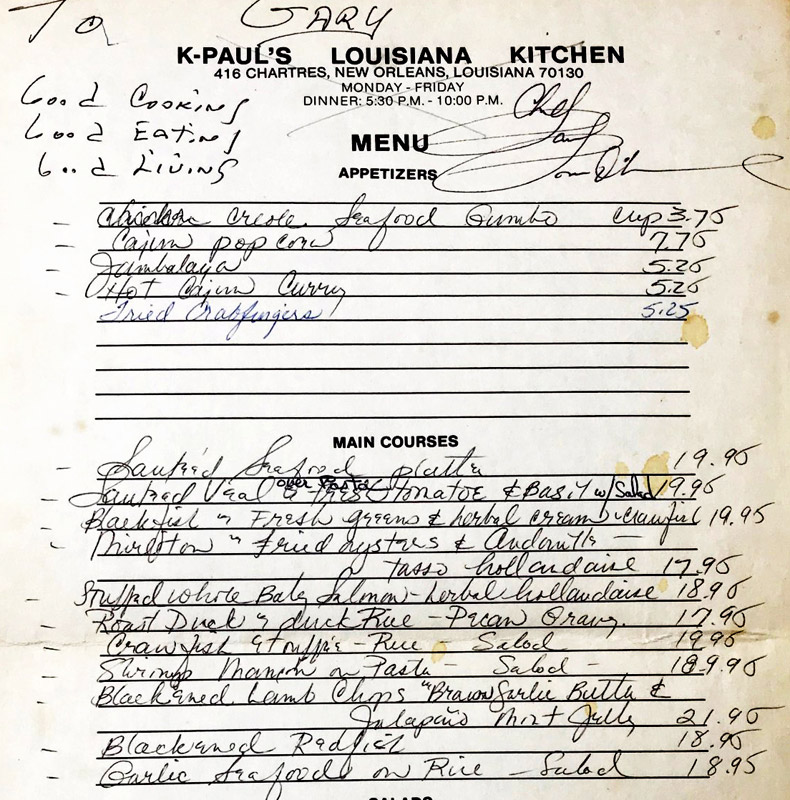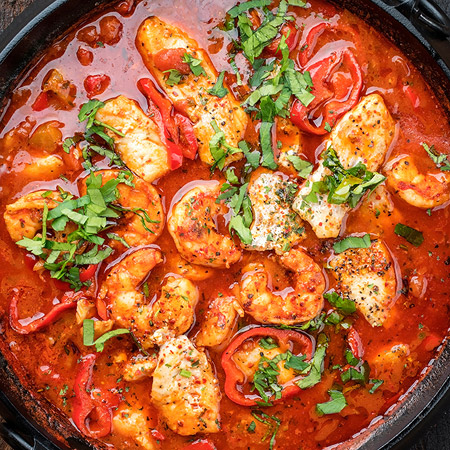
In 1984 I opened The Bayou Café, with my wife, Deborah Sponder. The Bayou Café soon became a successful Cajun/Creole restaurant in the heart of Carmel, California. I chose to feature Cajun/Creole food because I enjoyed the blending of diverse cultural influences to the foods of New Orleans, where I was born. Also, I was able to make use of my experience in cooking, wine and publishing a magazine about restaurants and the unique pleasures of regional foods.
New Orleans is world-renowned for its music, distinctive Cajun/Creole cuisine, and its annual celebrations and festivals, most notably Mardi Gras. The most famous of the local foods were, etouffee, po'boy's, red beans, and rice, Muffeletta sandwiches, Oysters Rockefeller (created in 1889 at Antoine's) and, of course, Gumbo.
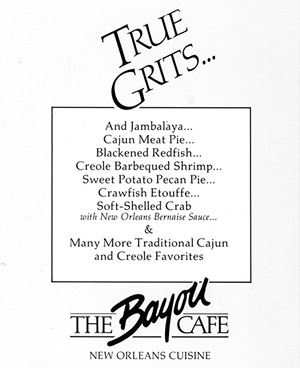
Click here to enlarge
I wanted to bring all the flavors and tempo of New Orleans to Carmel—to share with, many who may have never known the rich, diverse pleasures of Creole, Cajun and Soul Food.
The Creoles, were descendants of the settlers of colonial Louisiana. They created a cuisine, unique to New Orleans-a marriage of French, Spanish, West African, and Native American, featuring rich, sauces and complex preparation techniques that included seafood, onions, tomatoes, peppers, celery and okra.
The Cajuns, were descendants of the Acadians, French-Canadian colonists. They created a hearty, rustic cuisine partly based on French, and making use of the local ingredients including spicy peppers, shellfish, game, sausage and file' powder.
Also, there is the influence of Soul Food, created by the African-American descendants of slaves. Soul Food traces back to West Africa and usually feature wonderful and hearty foods made economically from what was available.

Once deciding on the food we would feature at The Bayou Café, I visited with famed-chef, Paul Prudhomme, at his "K-Paul's Louisiana Kitchen" in New Orleans. I sat next to this very big man as balanced himself on a stool, with the aid of his cane, just outside the kitchen before the restaurant opened. His cooks would present him with a tasting of each dish to be offered that night. He would nod his approval, or not. I would watch him as he served me another Cajun Martini.
For The Bayou Café, he helped me target menu items, theme and food suppliers and served me enough of those Cajun martinis to get my attention and then he aimed me to the bayou country for new 'adventures in dining.'
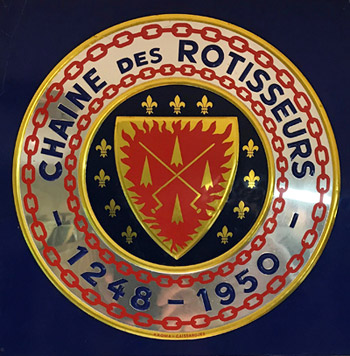
World's Oldest International Gastronomic Society
As much as I enjoyed the food in some of the other elite restaurants of New Orleans, like Commander's Palace, and Brennan's, and Emeril's, I was drawn to the favorite eating places outside of town in the swamp country of the Cajun Bayou. I recall taking a cab to one jewel of a restaurant far into a darken swamp, balanced on wooden platform over the water with just a few bare hanging light bulbs leading into a barely lit dining space of six tables, only two of which were occupied. Don't remember the name of the place but it was owned by an old weathered black woman who was also the cook. She was cast perfectly to engage your attention if not your life. When she spotted me standing in the doorway of her kitchen watching her cook, she said, "Come on in. Ya'll want to see how I'm making this?" I stood next to her at the old stove asking questions and falling in love with her style, generosity and presence. She would occasionally pat my arm with, "You see how I'm doin' this?" She was a living legend of Cajun.
Back at home in Carmel, I sought advice about starting this first restaurant from famed local chefs and foodie friends, including: Raymond Bergerac, from Maison Bergerac, Bert Cutino, from Sardine Factory, and Walter Georis from Casanova, all of whom offered their respective experience with French, seafood and European foods.
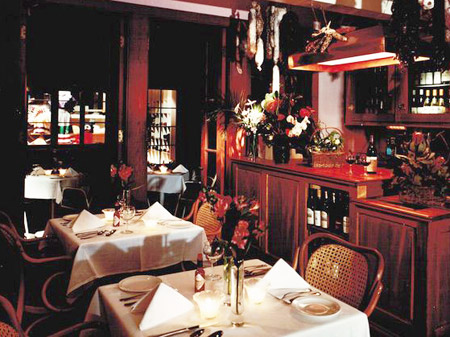
Two times a week we flew in our sausages, spices and shellfish from New Orleans; baked our own jalapeno corn bread muffins; taped historic jazz, blues and soul from the Louisiana region to entertain our dinner guests: Louis Armstrong, Benny Goodman, Ella Fitzgerald, Ray Charles, Etta James, Otis Redding, Billie Holliday performed for us while we served up Prudhomme's Cajun Martinis and joy. The seductive smells of exotic foods and the music of New Orleans poured from the windows into the downtown of Carmel. Customers lined up outside the restaurant waiting for dinner were teased with an appetizer of Fried Green Tomatoes (my own recipe) by a gracious server walking the line greeting folks.
Yes, we had our own bakery in the basement for making those Jalapeño Cornbread Muffins. My young son would run up the stairs with a tray of muffins-still-hot-from-the-oven to serve each guest.
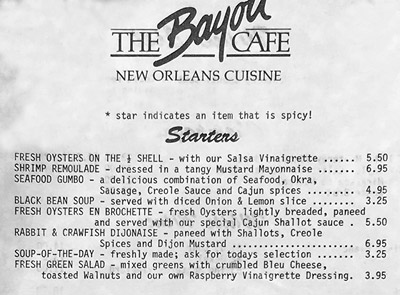
Click here to enlarge
Our dining rooms were a joyous and comfortable place to be. Often our dinner guests would break out in unified song to accompany the music playing over the tables in subdued light. There was an air of life-celebration and merriment. While reading this, think of Louis Armstrong singing, "What A Wonderful World," as this was the theme song of our restaurant. Each table had a printed copy of the lyrics for sing-a-long. Once each evening, the lights would blink, and the soundtrack and chorus followed.
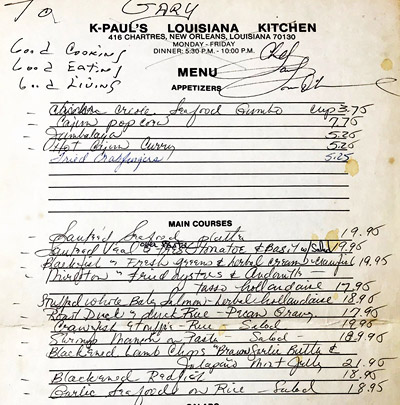
Click here to enlarge
Following my divorce and dissolving the restaurant, the menu, recipes and the Cajun/Creole concept was passed to my brother-in-law who started the world-renown Palace Café in Santa Barbara that became a favorite of Julia Child and many celebs from Los Angeles.
Today, almost forty years later, I regularly cook Prudhomme's "Shrimp, Okra and Andouille Smoked Sausage Gumbo." I make it in a five-gallon pot from The Bayou Café. It's a three-day affair. I make the gumbo my own with added ingredients and impulses. As it cooks, Dagma and I dance in front of the stove to jazz playing just for us. And after serving a couple of meals—it's better as it ages—I freeze the balance in containers for future dining.
As Tony Bennet said, "You were right Pops," "What A Wonderful World." And what a fine food experience this was for me, my family and friends.
Copyright Gary Ibsen All rights reserved.

